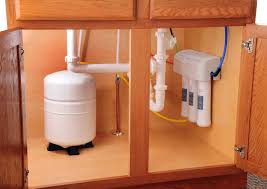Are you considering a water purification system for your home? It’s an important decision, especially in areas where water may be too hard and filled with chlorine to really be palatable. Of course, it’s also important to know how they work and what they remove before you make the investment. So, if you’re not yet in the know then it’s time you get some education. Read on and we’ll show you just how water purification systems work.
Why You Should Consider a Water Purification System
Most people assume that just because water is making it into the home it’s been treated properly and is absolutely clean. That’s not strictly true. While Federal guidelines are designed to make water safer there are still allowable levels of many contaminants that most people want to avoid. These include both chemical contaminants like chlorine and chloride compounds, as well as biological ones. These biological components of the water are the toughest of the microfauna that makes it through the water cleaning process. While tap water can generally be regarded as safe, those who are health-minded may want to take things a step further by adding a residential water filtration system to the home. In other places, high levels of calcium compounds can create hard water that leaves streaks and smears on every surface. In extreme cases, it can even cause you to not feel as clean after a shower. Water softeners are often added to filters to make things even cleaner. There’s a good reason that the industry is booming. Guidelines are just that, but a good filter can reduce these contaminants to completely negligible levels.
The First Steps of Water Filtration
There are quite a few different ways that water can be filtered but in a home system, the methods are fairly simple. The first step in many home water filters simply removes larger sediments from the water with a mechanical netting of some sort. These larger sediments are generally what lead to cloudy water in tap water. Mechanical filtration also uses a substance like activated carbon. This substance is extremely porous and as water is passed through it will trap the foreign substances in the microscopic pores which lace the surface of each individual grain. The effectiveness of a carbon filter is determined by both the size of the activated carbon granules and the flow rate. A faster flow rate, using more water pressure, will clean the water less than a slower one. In a residential system, this is important, since most people consider good water pressure an important part of their quality of life. In most cases, an activated carbon filter designed for home use will use a greater surface area rather than a lower flow rate to keep things going. Activated carbon is the ideal material for the initial stages of filtration. It’s even capable of removing organic molecules in many cases. It doesn’t remove everything, however, which is where reverse osmosis comes in.
The Reverse Osmosis Process
Reverse osmosis works by forcing the water through an extremely tight membrane. Technically this is called a semi-permeable membrane but in the end, it just amounts to the water needing enough pressure to pass through it. Nearly all of the particles, and definitely all of the microbes that remain, will be trapped in the sheet. The system then diverts some of the water to clean the sheet, allowing it to flow down a drain and out of the way. The end result is water that has had most of its contaminants removed. The RO process also works well for removing calcium, resulting in much softer water in areas where hard water is a problem. Contrary to some people’s opinions, RO water is perfectly safe to drink so don’t let anyone convince you to resalt the water. The RO filter is the heart of the unit but the membranes are often fragile. That’s why the extensive pre-filtering process is so important.
Post Reverse Osmosis Processes
In high-end home units, there are two further steps that can be taken. Reverse osmosis is fantastic but it doesn’t remove everything from the water. In some filtration units, a second activated carbon filter comes after the water goes through the reverse osmosis membrane. This usually uses a smaller carbon particulate than the pre-filter. This additionally removes most of the remaining particulates. UV sterilization is another process that can be used to further clean the water. This involves the use of heavy levels of ultraviolet light to kill any remaining microbes. While an RO system removes most microfauna, the UV light will kill even viruses to render the water perfectly sterile. For most places, these aren’t necessary, but these options are available to homeowners who wish to place the premium.
Is There More to It?
In order to find the right system for your home, you’ll need to undertake a water analysis before you can pick the right system for your home. Most reputable equipment suppliers will also do a water analysis for you and then guide you to the right choice for your home. A professional analysis is exactly what’s needed to make sure you end up with a system that perfectly suits your needs rather than just throwing money at a nonexistent problem.
Sound Like a Good Idea? Get Cleaner Water Today!
A home water purification system can be a great investment for a homeowner. It’ll allow you to get cleaner water and lower the damage to fixtures like faucets that can be caused by untreated hard water. Sound like a good bargain? If so, why not check out our services and see if we can’t get you on the right track to undreamed of water quality.


